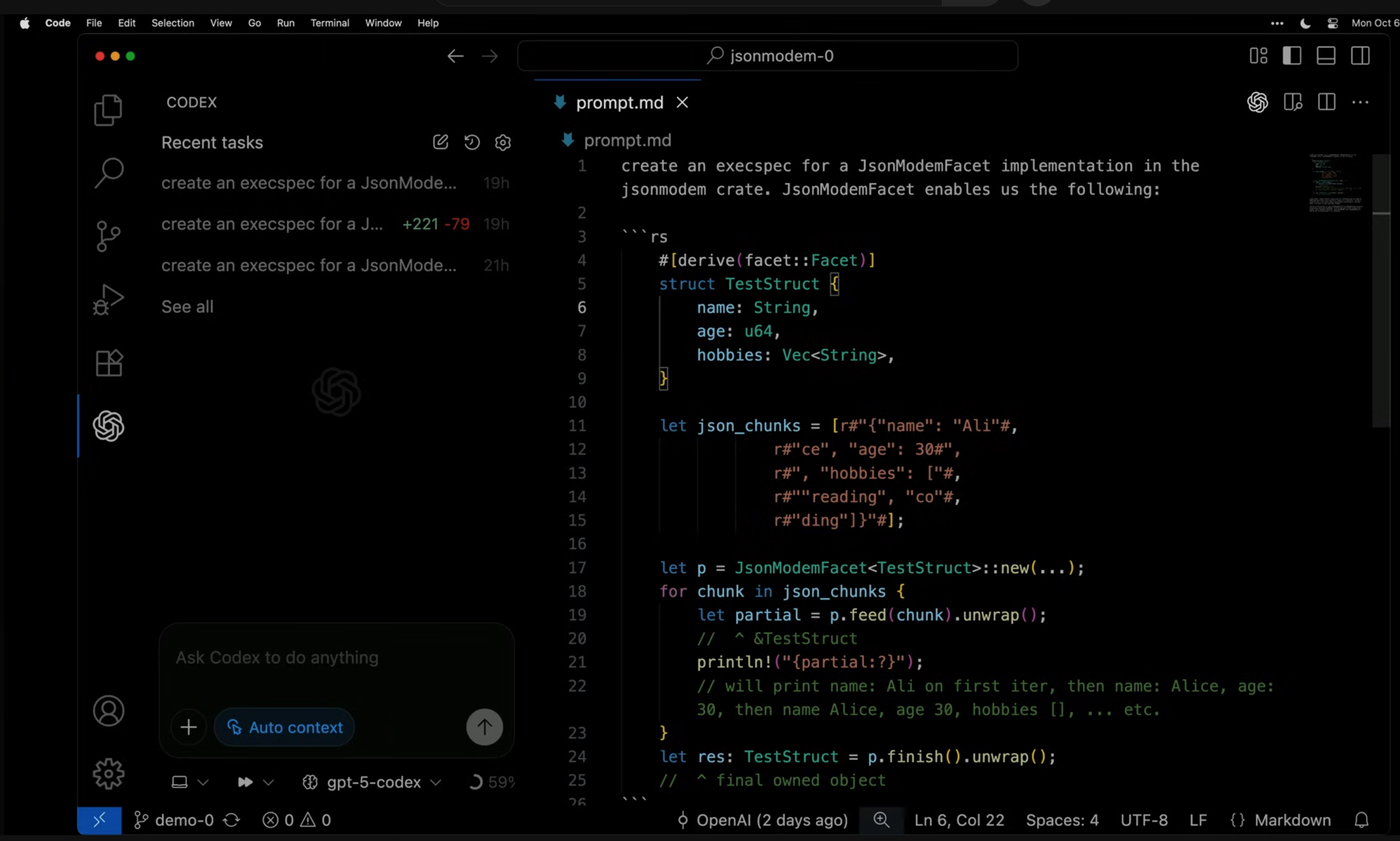Working with Codex
Planning prompts
Starting a planning session 1
I want to enable custom, unobtrusive update notifications and installs by customizing SPUUserDriver. Let’s start by planning the custom UI we’ll need. We’ll ONLY work on UI. Create a plan for creating SwiftUI views that can show the various states that are required by SPUUserDriver. I think the best place for these to show up is in the macOS window titlebars on the top-right. Create a plan to put it there. Consult the oracle.
Starting a planning session 2
I’ve got an idea I want to talk through with you. I’d like you to help me turn it into a fully formed design and spec (and eventually an implementation plan) Check out the current state of the project in our working directory to understand where we’re starting off, then ask me questions, one at a time, to help refine the idea. Ideally, the questions would be multiple choice, but open-ended questions are OK, too. Don’t forget: only one question per message. Once you believe you understand what we’re doing, stop and describe the design to me, in sections of maybe 200-300 words at a time, asking after each section whether it looks right so far.
Starting a planning session 3

Developer created file called prompt.md
Add multiplayer to a simple game
Chatgpt suggested this one:
I have a simple turn-based game written in Python using Pygame. I want to add multiplayer support so that two players can play against each other over the internet. The game is currently single-player only. Can you help me plan out how to implement this feature? Please provide a step-by-step plan, including any necessary changes to the game’s architecture, networking considerations, and how to handle player turns and synchronization. Let’s start with a high-level overview of the steps involved.
Alternate start from a 5m codex video:
Write a plan to implement multiplayer
Develop session
- “Consult the oracle” kicks an agent into a “deeper thinking” mode which often produces better results
- Starts with a plan because he doesn’t know what the feature should look like and do yet and he won’t get a lot of value out of sending an agent off to write a bunch of code initially
- The plan is saved to a file like spec.md and often included as context in future conversations
- Uses AI for inspiration
- Getting from 0 to 1 is hard and is like staring at a blank slate
- Use the AI to give you something … anything
- Often the first iteration is thrown away
- Sometimes he does the work manually
- Almost always he has a better sense of what he wants after working with it
- Be able to tell when the agent is producing junk
- Review everything and for stuff that isn’t understood he will try to learn about it
- He learns in parallel with the agent (doesn’t walk away after a green bar)
Cleanup session
- Agent is asked to refactor and add documentation
- Documenation helps future work by humans and agents
- Agents work better if they can review code and written documenation
- Refactoring well means a human has understood everything and not blindy accepted what an agent has written
- “Cleanup == anti-slop session”
Failure and what to do next
- Sometimes you can’t get an agent to do what you want it to
- Along the way it’s best to be learning about what you’re trying to do
- You’re prompts should be getting closer to the correct work you want to see
- You can choose to
- Put the work down for now and move on to something else (Maybe after more context is available the agent performs better)
- Or do it manually
Scaffolding out a feature
- Sometimes starting with a few empty classes, methods, and documentation is a good strategy
- “Fill in the black” or “Draw the rest of the owl” are patterns ai is good at
Sometimes helpful starting prompts
- “I broke a bunch of things, please fix my mess”
Codex commands
- init - reads files in a directory and generates an agents.md file
- approvals - read only for the llm or directory only (auto) or full access
- model - switch to a simpler / harder reasoning model
- codex resume - continues a session started previously
Links
- Vibing a Non-Trivial Ghostty Feature: Mitchell Hashimoto vibe codes an update feature in ghostty
- The 7 Prompting Habits of Highly Effective Engineers: Nice list here of ways to think about asking for help:
- “Draw the rest of the owl”
- Checklist
- Write Plan
- Write a checklist
- Do the checklist
- Delete the checklist
- Just tell it to try something (if it gets it wrong it’s fine)
- Throughput > latency (Start multiple tasks at once)
- Try giving a goal not detailed instructions and commands to validate work
- Git it to summarize a long article or documentation
- Vibe engineering: Simon proposes a step past “vibe coding” where an agent is able to plan, design, code and crucially test their output while maintaining quality. He talks about working with existing code bases rather than greenfield ones. The better we get at automation and describing our tools, thinking, and process to documentation the better our agents will get. Allegedly. :)
- How to write a great agents.md: Lessons from over 2,500 repositories: Guidance on writing prompts for subagents. Are subagents still the way to go?
- Third Stage Engineering: Performance considers hardware, software, and whatever tuning you have to go to get the most out of a system
- Prompting best practices
How Programming Changed: “70% of my lines of code is now written by Claude Code” :/
Good article overall. The section on the impact claude code had on this developer’s workflow is wild …
2025 was a epochal year for the field of programming. LLMs got good enough. I’m finding myself using Claude Code almost every time I open up my editor, and it’s capabilities feels to have had quite a boost with the introduction of Sonnet 4.5. For the engineers who use Claude Code in our team, we’re finding it can drastically speed up, or allow for parallel work. If I had to guess, I’d estimate about 70% of my lines of code is now written by Claude Code.
6 month down the line I’m still regularly impressed by Claude’s ability to understand our codebase, and I can find that I can make requests which span multiple sub-projects “add a ‘display name’ to this model, and make it editable in the studio” would make the correct changes to the db, the GraphQL SDL layer, the application API layer, the backend would get forms and fields updated. This sort of thing is the bread and butter of a well defined system, and the tooling continues to impress.
We’ve explored the idea of having Claude Code or Copilot running on web/hosted infrastructure, personally, I’ve found it uninteresting. While these tools occasionally can do a one-shot exactly what we were looking for, most of the time you need to clone the branch and make your own changes. Could have just asked locally. I think it’s useful for making something for you to come to later, (e.g. you’re in a lot of meetings in a row, or you’re off for the day and want to have something to start with tomorrow) but to me the right abstraction is still that the tool is running locally and being supervised/guided by a developer.
Because of Claude Code, I feel like I am continually asking myself: how do I make this codebase more explicit and each abstraction boundary more obvious? We’ve moved the monorepos to contain all context and code about their scopes, I’ve worked to remove as many ‘any’s as possible and I test out every new feature for Claude Code.
I even started a meetup with a friend to get the chance to talk to others who are figuring out this strange new piece of technology. I’d like to do a final introspection on using Claude Code on this blog after this one is shipped.


